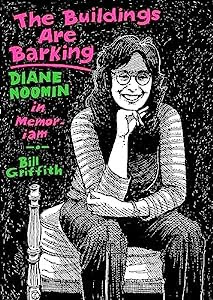.
A couple of decades ago, I was in the waiting room of the Jiffi-Lube with the pervasive smell of free coffee and well-fingered copies of Sports Illustrated while my car's oil was being changed when an ordinary-looking man struck up a conversation. He was a widower and he wanted to talk about his late wife. What a remarkable woman she was. How much she meant to him and they to each other. And, finally, how their time together, over so many years, made life bearable for him now that she was gone.
Then the mechanic came in to tell him his car was ready. He smiled and shrugged and apologized for boring me. Then he was gone, taking his ordinary story with him.
What an extraordinary thing a good marriage can be!
Which brings me to this review of The Buildings Are Barking: Diane Noomin in Memorium by Bill Griffith. Noomin and Griffith were both underground cartoonists back in the day. Griffith is best known for Zippy the Pinhead which, improbably, became a daily newspaper comic strip. Noomin was best known for Didi Glitz, a loud-mouthed, abrasive, transgressive, big-haired, short-skirted portrait of everything the cartoonist ever feared becoming... and yet possessed of a humanity that is hard to deny. I had no idea before picking up this 24-page comic that the two of them were married.
The book is heartfelt.
It is first of all a convincing portrait of grief. It is also a paean to Griffith's wife and an acknowledgement of all she meant to him and to his work. It is a recognition of Noomin's importance as a pioneer feminist cartoonist--and a major one. And it is a prayer by a heartbroken man that he may someday find solace.
But to me the most moving part of the work is the last panel of page 18 when Griffith is about to write about what his wife was like when they first met... and cannot. He is interrupted by one of his regular characters, Ko-Ko the Clown, who leads him into a final fantasy that closes the book quite nicely. The caption reads: '"She was... um... she was..."
Here I must insist on my authority as a professional writer for most of my life. I read this panel as the author reaching to describe who his wife was, independent of him, and failing. Not because he couldn't put it in words but because if he did those words would go on forever. Whereof one cannot speak, thereof one must be silent, as Wittgenstein said.
So Griffith cut to the conclusion. As a fellow husband, I have to respect that.
This is a short work, only two dozen pages long. But if a picture is worth a thousand words, then by my count this is something like 140,000 words long. Which is to say, it is a novel.
Oh, and as for what Diane Noomin was like? Griffith's portrait of her on the cover says it all: She was a talented, competent, confident, and attractive woman who knew her husband loved her.
And here, in parvum, is her ordinary/extraordinary story.
*




No comments:
Post a Comment